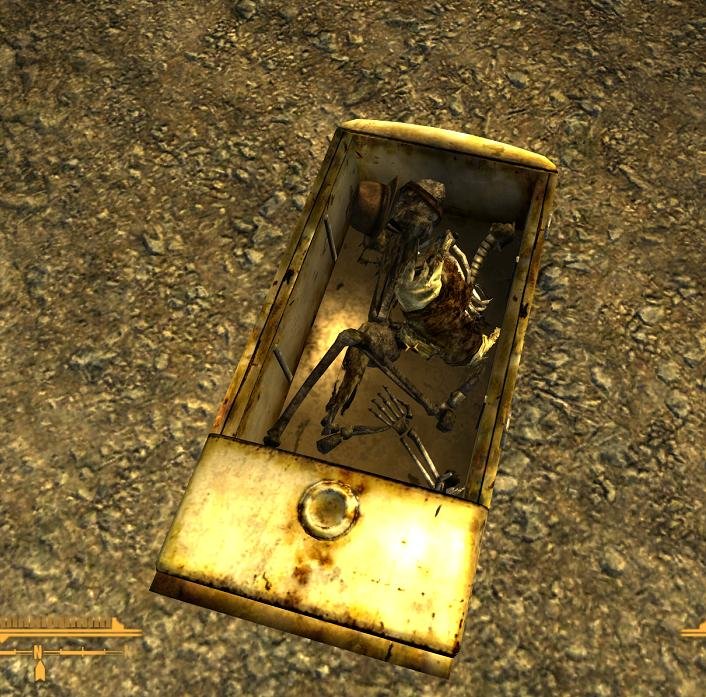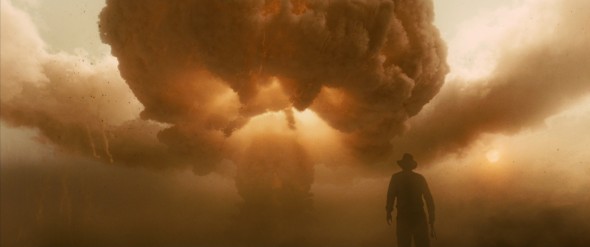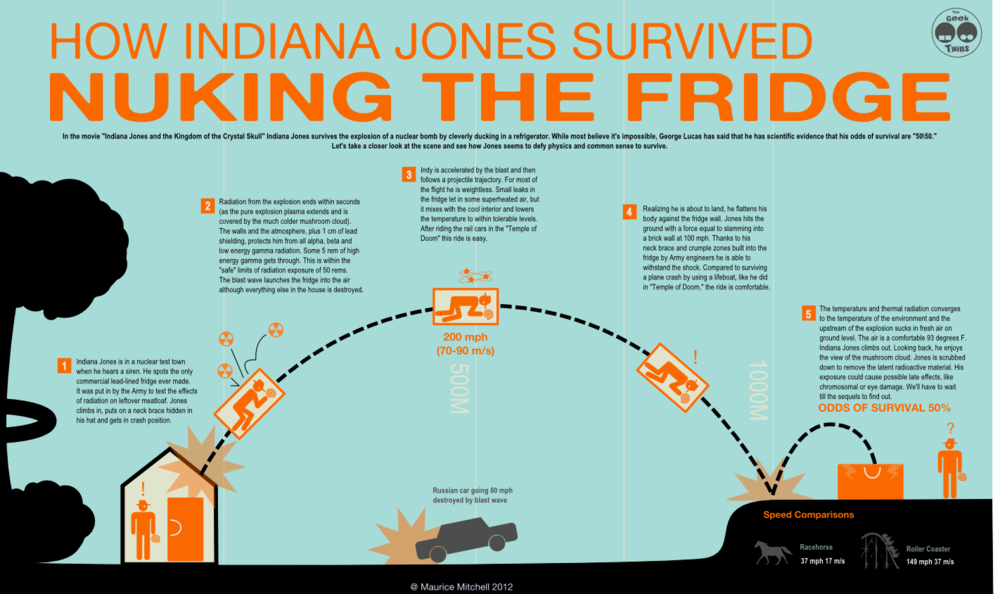The movie Indiana Jones and the Kingdom of the Crystal Skull was released in 2008 and it was the first Indiana Jones movie in 19 years. While the movie was well received and a major box office success, the movie was considered by some to be more of the same or “same old, same old,” while others called it the worst of the series. Regardless, the movie is indeed the “same old, same old” meaning that the movie has gaping plot holes which make no sense in regards to previous movies, plot elements and science. Since this is a physics blog, I am obviously going to be examining some of these scientific errors. The one I am going to be focused on is the scene early on in the movie where Indiana Jones narrowly avoids certain death by jumping in a refrigerator in a lightbulb moment. Miraculously despite being launched several hundred meters, Jones roll out unharmed and with his hat still on his head. This obviously could not have happened as he would have been dead in a multitude of ways. Although, “The odds of surviving that refrigerator — from a lot of scientists — are about 50-50,” Lucas said in a New York Times article.
 |
| 1950 Studebaker Commander (looks very similar to car in movie) |
First some preliminary assumptions and calculations need to be made in order to determine the physics of this scene. Without any information, it would be impossible to calculate the magnitude, temperature, forces, and radiation without the power of the detonated bomb and the distance from Jones in the fridge. Since the movie is set in 1957 in the Nevada desert involving nuclear explosions, it can be assumed that this situation is modeled on the US Military’s Operation Plumbbob which consisted of 29 explosions over a five month span. Since the scene in the movie showcases a tower test of which there eight during Plumbbob. These explosions ranged from 10 to 44 kilotons or 20,000,000 to 88,000,000 pounds of TNT.
 |
| How Indiana Jones should really have looked following the nuclur explosion |
Determining, Jones's distance from the explosion is much more complicated but using some inferences and observations it should be possible to determine the distance. As seen in the video, the bomb’s expanding edge of the shock wave seems to meet fridge all at once delivering all of its concussive force at once. Therefore the fridge undergoes rapid, uniform acceleration to a constant vf. With this assumption I must calculate the force inflicted upon the fridge to accelerate the fridge to its final speed and then calculate the distance he must be from a 10-44 kt detonation to receive a force of such a magnitude. Using the dimensions of the fridge I found online (link below) made in a 1950’s retro style, the fridge weighs about 71 kg and if Jones weighed around 99 kg, the total mass is 170 kg. Assuming the Studebaker, the Soviet villains are driving in the scene is a 1950 Studebaker Commander, the vehicle is 2.3 meters long and presumably traveling at its max speed (80 mph or 35.76m/s) to escape the blast radius. However Jones, overtakes the car in a shot .9 of a second, meaning his horizontal velocity has to have a magnitude of roughly (2.3 m/0.9 s + 35.76 m/s) = 38.32 m/s. I am not going to deal with vertical velocity due to a multitude of information which can not be determined from the movie, therefore all the forces found will be lower estimates. Jones’s net change in momentum (mass*delta v) can be calculated as 170*38.32 = 6514.4 kg*m/s. Considering that the atomic bombs dropped on Hiroshima and Nagasaki created blast winds close to 277 m/s, the comparably powered blast would have overtaken the fridge in .7 m / 277 m/s = 2.5 milliseconds. This means that the force exerted on Jones would be impulse divided by time 6514.4/.0025 = 2,605,760 Newtons. To put this in perspective, a 180 pound man on Earth would weigh around 800 newtons meaning that this much force applied would be like having 3257 people sitting on your chest at the same time. Sounds survivable, George Lucas. If these blast winds were striking the rear plate of the fridge perfectly they would be apply 2.605 mega newtons of force onto an area of just 1.46*.6 m = .876 meters squared. The pressure exerted on the back of the fridge would then be (2,605,760 N/0.876 m²) = 2,974,611.87 Pascals = 430 psi. Using the table from the Wikipedia page on the Effects of nuclear explosions, Jones must have been much closer than .6 km to the epicenter of the blast.
With this information discovered, I can now calculate all the different mechanical ways in which Jones would die in this predicament. First, he would be crushed under the shockwave as the 2.9 MPa required to accelerate the fridge is 47 times the pressure needed to remove a railway car from its track and crush it like a tin can (again see the Effect of Nuclear Explosion). Even after the force destroys the entire city it is still sufficient to crush the Soviet’s car, which showcases that the pressure would be great enough to completely destroy the fridge not lift it. Secondly, 2,605,760 Newtons acting on a 170 kg mass would create roughly 1560 G forces worth of force, which would almost be great enough to launch a person into space. Considering the world-record for acceleration survived by a human in a lab is just 42 Gs which caused serious injuries, it seems that Jones would not survive this brutal acceleration. These calculations were also made with the assumption that the human body is rigid while is really highly flexible. Most obviously, the probability of Jones's neck snapping from the sheer acceleration or causing severe head trauma is very high as the torque would rip apart the hinge point.
 |
| This image shows that Indiana Jones would have been far too close to the exsplosion and would have been a victim of radiation and "reverse blast wind." |
Aside from these mechanical ways I covered, Jones would also die from thermal reasons, aerodynamic reasons and radiation. Thermally he could die from molten lead or incendiary air scorching him, and being baked alive. Aerodynamically, he would have suffocated in two different ways and would have been pulled back into the explosion by a massive influx of air or “reverse blast wind.” Finally, the radiation from this nuclear bomb would cause Jones to succumb to death in a multitude of reasons. In short, George Lucas was wrong about this scene and Indiana Jones would have been very dead following this scene preventing the rest of this terrible movie from taking place. Sorry Harrison Ford.
Below is a video of the scene in question from the movie:
Below is a video showing "reverse blast wind"
Sources:

Comments
Post a Comment